Table of Contents
Ah, the money belt. Emblem of the anxious, insecure traveler or lifesaving secret stash for your most precious valuables?
Travelers are divided on the best way to keep your cash and cards safe while you travel, but the way we pay for trips, book accommodation, and even carry cash on the go have fundamentally changed in the past decade—and so has the need for money belts.
ATMs are everywhere, international credit card fees are practically zero, Venmo is a thing, and traveler’s cheques don’t even exist anymore. Cash is becoming both less important to travel and easier to get on the go, making one of the staples of travel gear—the money belt—obsolete.
Is the money belt dead?
The Changing Currency of Travel
When I first started traveling over 10 years ago I carried traveler’s cheques (yeah, you spell them with a “qu”). For all you millennials, traveler’s cheques were magic monopoly money that you pre-paid for at the beginning of your trip. You could use them like cash at hotels and restaurants, and the best part was—they were essentially theft-proof.
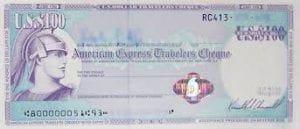
If your traveler’s cheques were lost or stolen, you simply called American Express (using a payphone and your sweet international calling card) and they’d cancel the existing cheques and reissue them. The process was a pain, but it provided a lot of peace of mind when carrying your whole wad was commonplace.
Barring traveler’s cheques, your only other option was to carry a significant amount of cash because ATMs didn’t work the way they do now. Either your US debit card didn’t work at all, or the international fees were so high you had to pull out hundreds of dollars at a time, thus creating the same cash-heavy anxiety while staying in a sketchy hostel or on crowded European streets.
I remember constantly patting my pockets to reassure myself that I had my cash with me, and yes, I had a money belt (that I rarely wore) in my backpack. It was a stressful way to travel.
Once, back in 2008, I actually had to fight off a handful of guys at a Spanish train station in the middle of the night because all the money I had in the entire world was in my pockets and they wanted it. If I’d been robbed I would have been up a creek without a Euro. I don’t recommend it.
The Money Belt
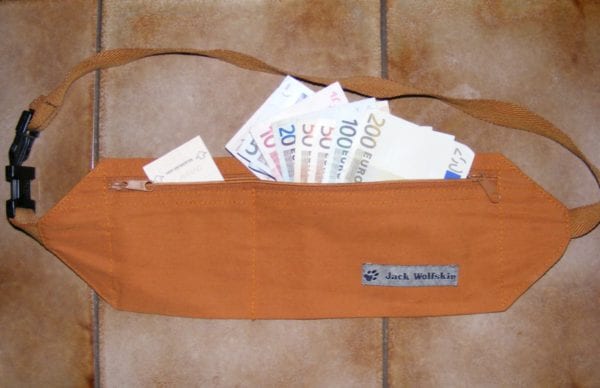
The solution to carrying all this cash abroad was the money belt. Designed to lay flat against your waist (or dangle around your neck, if you’re one of those people), the money belt was a place to keep all your cash safe from pickpockets, thieves, and forgetfulness. Every morning you clipped it on and hit the streets.
The only problem with money belts is, well… everything.
Four Big Problems with Money Belts
To put it simply, I have four major problems with money belts:
- Money belts look (and feel) ridiculous
- Money belts advertise that you have valuables (and where they are)
- Money belts are (functionally) useless
- Money belts are a declaration that you don’t trust anyone
Money Belts Look Ridiculous
The whole point of a money belt is to keep your valuables safe by being inconspicuous. The only problem is that money belts are the opposite of inconspicuous. The second you put a few bills, and probably your passport inside, you look like a kangaroo.
A kangaroo with a lot of cash.
Using your money belt is an even bigger problem. When you’re in a crowded market trying to buy a few chotchkies for your friends and family, you have to lift your shirt (showing off that pasty belly), unzip your money belt, sift through ALL your money digging around for small bills with your neck craned like an idiot, then wait with your belt (and belly exposed) for change, only to do it all over again if you want to buy a taco.
Even worse, bills and cards can fall out if you’re in a hurry, and pickpockets can get at your cash while you’re exposed. Plus, you look like a moron.
And did I mention the sweating? Money belts are designed to be worn next to your skin. I’ll say that again. You have to wear a thick, polyester sack on your lower back or belly all day. While you hike, walk through town, or bike all over.
Money belts are a sweat factory, even in colder climes. Forget about wearing these in SE Asia. Your money will dissolve.
Money Belts Make You a Target for Theft
The other big problem I have with money belts is the lack of basic functionality. A money belt is designed to keep your cash and cards safe, but the way you use them (see above) makes your cash and cards obscenely visible.
You have to expose all of your cash just to get a little, making them an advertisement for the location and value of the cash you’re carrying and eliminating any benefit of a hidden travel pouch.
They also immediately mark you out as a tourist—and not a particularly savvy one.
Money belts are bulky, tough to use, and brand you as a travel rookie—all of which makes you a prime target for theft at worst and inflated prices at best.
The first rule of avoiding theft is to be the least likely target. Even when used properly, money belts do the opposite. You show thieves where your valuables are, advertise exactly how much you’re carrying, and demonstrate your lack of travel tact. A perfect storm for a mugging.
No thanks.
Money Belts are Functionally Useless
The reason that money belts exist is that people used to travel with lots of cash—sometimes all of their cash—on them all the time. ATMs just weren’t a thing, and foreign transaction fees for credit cards were steep.
People don’t travel like that anymore. You don’t pay for your lodging with cash—you book on AirBnB or Hostelworld. You don’t even pay for taxis with cash—there’s an app for that.
And if you do need cash, you can withdraw a reasonable amount from the ATM every few days with low (or no) transaction fees.
Money belts are a vestige of a bygone era of travel. No one travels with heavy leather trunks anymore. Don’t travel with a money belt.

Money Belts Scream, “I Don’t Trust Anyone!”
My biggest problem with money belts isn’t their basic failure as travel gear. Lots of travel gear sucks, but not all of it makes you a hostile, even ignorant traveler. Money belts do.
Attitude is everything when you travel. The prejudices you carry with you inform your entire trip. That’s why some people can visit the exact same place on the exact same day and have wildly different experiences.
If you think you’re going to be robbed or taken advantage of at every turn, you will be. Why? Because you’re projecting that impression every time you wear a money belt. You don’t see people as locals living their lives, but as potential thieves and swindlers trying to weasel their way into your wallet.
This is an awful mindset and one that I commonly find among travelers that are overly worried about securing their valuables.
I’m not saying that you should walk into every situation with wide open arms and a trusting heart—traveling well takes a bit of an edge. I am saying that your default setting can’t always be aggressive mistrust, but that’s exactly what a money belt projects. Every morning when you strap that on, it’s a physical (sweaty) reminder that people are out to get you. It informs your posture, your stance, and your daily interactions with people.
*Steps off soapbox* I know that’s kind of hippy of me, but your attitude really does make all the difference. Find a simple, secure way to carry your cash, and stash the rest in a safe place separate from your person, and then just enjoy your trip. Bad things may happen, but anticipating them at every turn is a great way to ruin a lot of incredible moments.
The Pros of Money Belts
I know that some of you still cling to your money belt with white-knuckled grips, and that’s totally ok. Everyone travels differently, and if a money belt provides you with peace of mind on the road, that’s fantastic.
I will acknowledge that while I think there are better alternative solutions to money storage while traveling than money belts, they do have a few redeeming qualities.
Money Belts Keep You Organized
Money belts keep your finances organized and all in one place, and I know plenty of travelers that bring a money belt along as a kind of secondary travel wallet.
Money belts help you divide your finances between your wallet (everyday use), and your trip money (deep storage). Money belts are also a great place to store an extra credit card for emergencies, as well as documents like your vaccination card or e-visa so they’re always with you, if not readily accessible.
Money Belts Give You Peace of Mind
Travel is a skill acquired over time. You’re not going to be good at it out of the gate. Even if you read a thousand articles full of advice, your first trip (or even your 10th) is going to have some stress built-in, especially around money and valuables.
If a money belt is what you need to feel secure, go for it. Over time, you’ll learn how you like to travel and what works best for keeping your money safe.
I think of a money belt as training wheels for travel. Sure, it’s awkward and makes you look like a dork, but it’s way better to have something there to stop you from smashing your face into the pavement. Wear a money belt until you don’t need it anymore, then chuck it in the trash and travel like a big kid.
Money Belt Reviews
Eagle Creek Undercover Money Belt ($20)
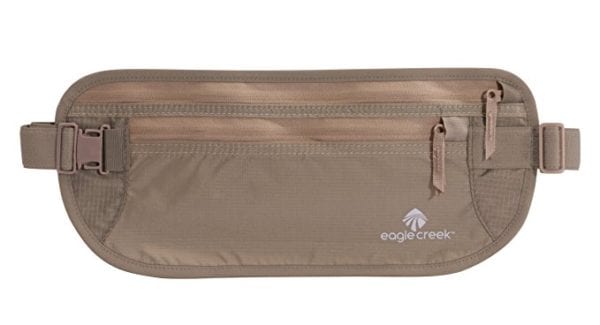
Easily the most well-liked money belt on the market, Eagle Creek’s undercover money belt is a sleek, simple 2-zipper pocket money belt. It’s exactly what you’d expect from a money belt, and at $20, it’s worth a shot.
FlipBelt Zipper ($34)
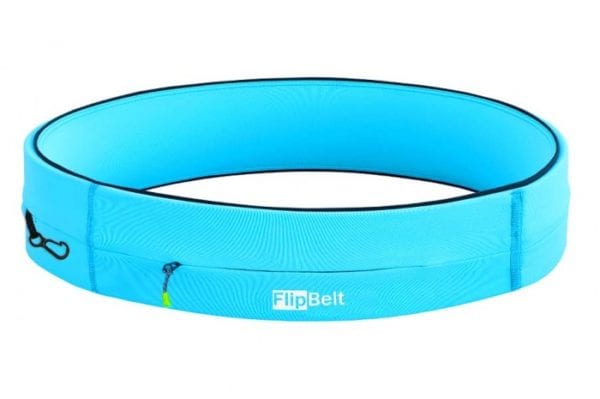
Originally designed as a place for runners to keep their phone, keys, and a few bucks handy on a run, FlipBelt is oddly well-positioned in the travel money belt market. Made from a comfortable, flexible fabric, it contours well to your body, and the best part—it’s not designed to be hidden under your shirt against your skin.
The original FlipBelt had a few simple stash pockets (no zipper) that you’d store items in and then flip it inside out so they were safe on the inside, against your hip. The zipper edition still has two of those pockets, and a key attachment, but also features a zipper pocket for extra security. Once you flip the belt inside out, you can’t see the zipper or the pockets, making it a better version of the money belt in terms of access (you just reach in the belt strap) and camouflage. This money belt hides in plain sight.
Money Belt Alternatives
Honestly, you don’t need a money belt. You probably won’t have that much cash on you, and even if you do, a money belt isn’t the way to go. So to keep you from looking like a tourist, here are my favorite alternatives to the money belt.
Travel Pants with Zippered Pockets
Where’s the best place to keep your money? Close to your body in a zippered pocket. But you don’t have to don a sweaty money belt to do that. Simply invest in a pair of comfortable, functional travel pants that feature a plethora of places to stash your cash.
I’m a big fan of:
Bluffworks Tailor Fit Chino Travel Pants ($125)

These pants are comfortable, stylish, and not “travel looking” even though they have some great travel features like zippered pockets. Chinos that feature well-designed deep pockets (nothing will fall out while you’re seated), with additional interior zippered pockets for extra security. Toss emergency cash in the zippered pocket and forget about it.
A great way to divide your valuables between your wallet and your emergency stash.
Clothing Arts Pickpocket Proof Travel Pants ($110)

These travel pants are definitely a security upgrade if that’s your major concern. Featuring 11 pockets—5 double secure pockets—these pants will definitely keep you safe from pickpockets. While it may take you an extra minute to get your money out, you won’t get robbed. So that’s awesome.
A Fanny Pack, Bum Bag, or “Awesome Sauce Waist Pouch”
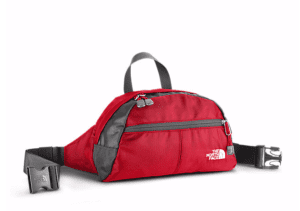
Yes, people from different parts of the world use different names for this bag. Let’s all move past that.
If you really, really want to wear a money belt, just own it and upgrade to a fanny pack.
A fanny pack is actually an awesome alternative to a burdensome daypack, and you can keep it on you at all times. I especially like fanny packs when I’m biking through a city (I do that a lot) since it keeps everything at hand without strapping it to my back.
Fellow Junyuan writer and travel ninja Shannon Whitney recommends the North Face Roo ($34), and I gotta say, it looks pretty sweet.
Fanny packs are the sweat-free alternative to money belts, and they can actually carry a few more everyday items like headphones, a snack bar, and even water if you go for the tactical route.
If you think they make you look foolish, it’s all in how you wear ’em. You’ve got to own it. I embraced the power of the fanny pack a few years ago in Paris. Rocking a bright pink one with an Eiffel Tower zipper, I actually got stopped to take photos with locals a few times. If you’re going to look like a tourist, do it on your own terms.
DIY Deodorant Safe

I like to keep emergency money and cards separate from my body while I travel, that way if I’m mugged or just lose my wallet, I always have a backup back at the hotel. My preferred method is to use the inside of a deodorant stick. Simply pop the top off, insert emergency cash and a credit card, then pop the top back on. It works best with a half-used stick, and bonus—you can still use it as a deodorant.
Venmo & Paypal
You know that feeling of finding a $5 bill in your pocket out of nowhere? That’s the feeling of realizing you have $500 in your Venmo account. Ditch the money belt completely and go digital.
When you pay with things via Venmo or PayPal on the road it feels like free money. I particularly like using Venmo to pay back a friend for incidentals while we travel if they have cash.
That way, you reduce the number of times both of you go to the ATM, and there’s no weird IOU build-up. You just send a few bucks to your buddy when you have WiFi or service and you’re all good.
Pro Tip: Load your PayPal account with $500 before you leave for your trip. That way, even if your wallet and phone get stolen, you can still pay for hotels or tickets on a public computer.
Money belts are outdated, awkward, and honestly kind of bad at the thing they’re supposed to do. They don’t keep your valuables safe from pickpockets, nor do they keep your money hidden.
Ditch the money belt and upgrade to a holistic travel system of travel pants, digital currency, and no ATM fees with cards and checking accounts like Charles Schwab. The money belt is dead. Let’s dance on its grave.
Ten articles before and after
Packing Tips for Traveling with Musical Instruments – JUNYUAN Bags | Professional Bag Manufacturer
Is a Backpack a Personal Item? – JUNYUAN Bags | Professional Bag Manufacturer
Types of Backpacks – JUNYUAN Bags
How To Pack A Carry-On For One Bag Travel? – JUNYUAN Bags
How To Wash A Backpack? – JUNYUAN Bags
The Best Mini Bluetooth Speakers for Travel – JUNYUAN Bags | Professional Bag Manufacturer
Nylon vs Polyester: Which is Better for Backpacks? – JUNYUAN Bags | Professional Bag Manufacturer




 Mobile/What's App/Wechat
Mobile/What's App/Wechat E-Mail
E-Mail ADD
ADD




